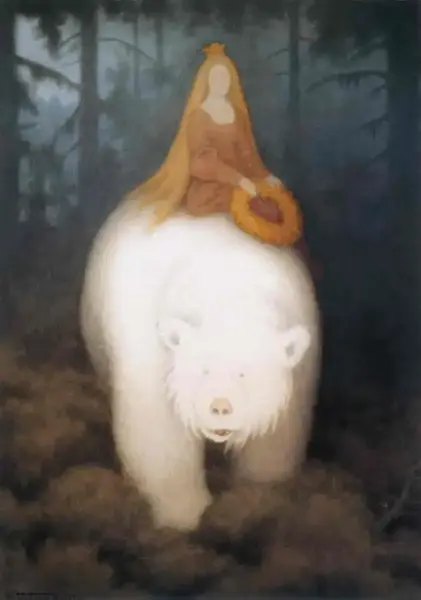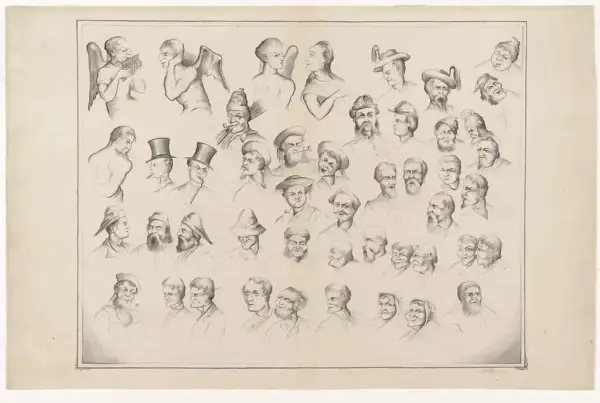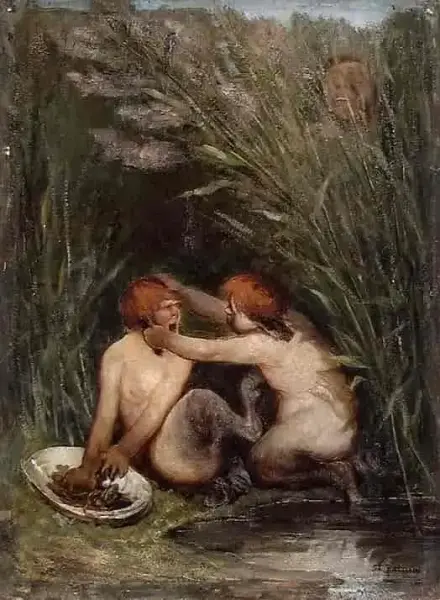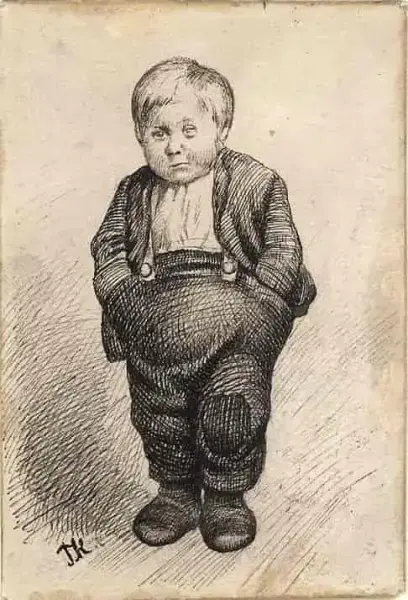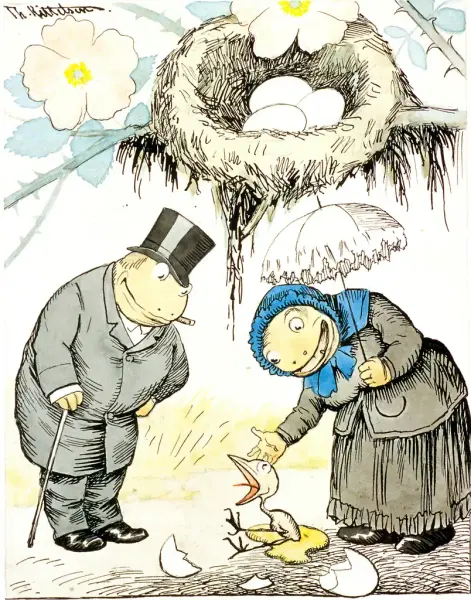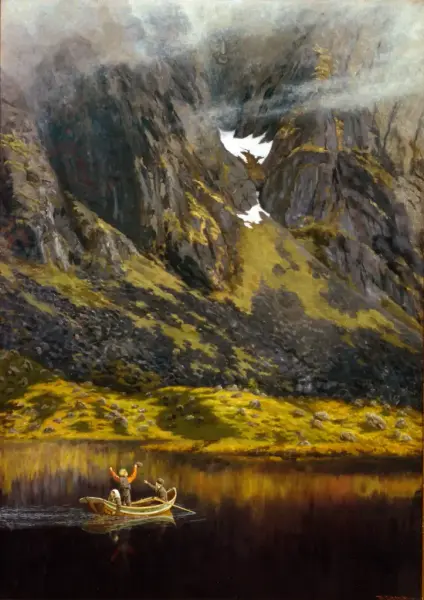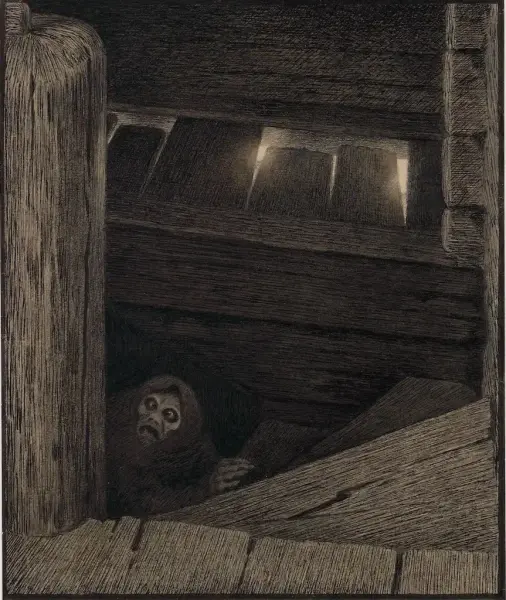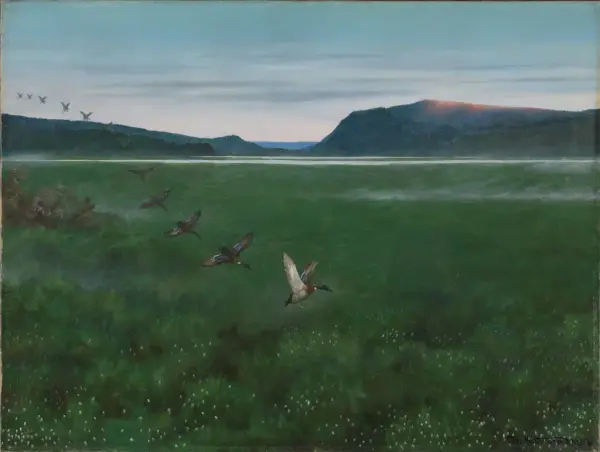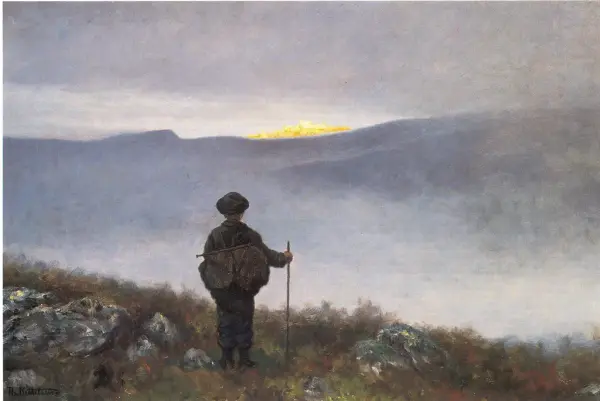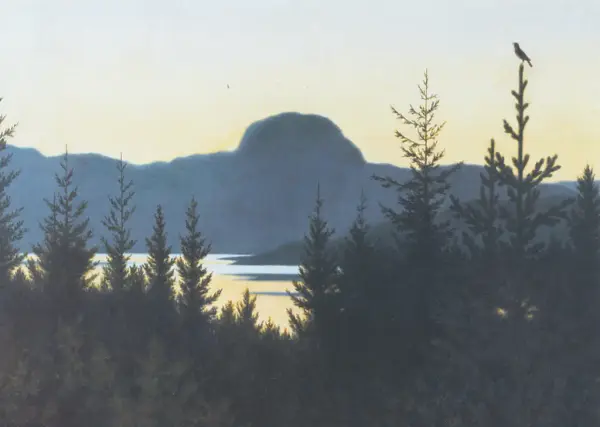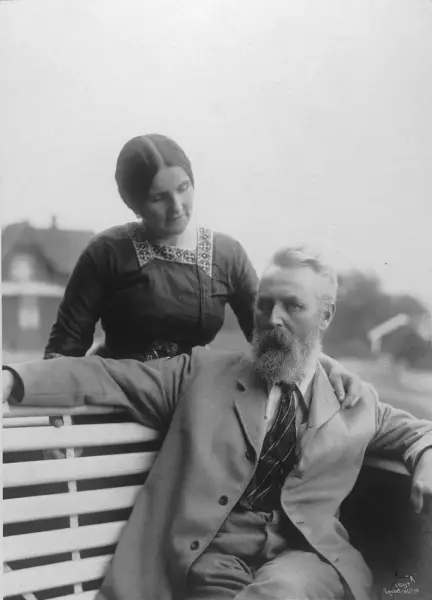-
Kvitebjørn kong Valemon Theodor Kittelsen
Theodor Severin Kittelsen was a Norwegian visual artist, caricaturist, illustrator and author. He is particularly known for his imaginative illustrations for Asbjørnsen and Moe's folk tales and his evocative motifs of mythical creatures and landscapes. He published several illustrated books with his own texts, both humorous and poetic. Kittelsen was inspired by Norwegian nature and folk culture and created a unique world of images that has become part of the Norwegian identity. Some of Kittelsen's most famous works are the books "Svartedauen" and "Har Dyrene Sjæl?" as well as the motifs Nøkken, Skogtroll and Pesta i trappen.
He worked in various techniques, such as pencil, pen, watercolor, oil, charcoal and mixed media. Many of the motifs balance at the intersection of fantasy and reality. He achieved something magical by placing supernatural creatures such as gnomes, trolls, elves and hulders in a Norwegian natural landscape. At the same time, the fantasy creatures appear realistic.
Kittelsen was a fairy tale illustrator for Asbjørnsen and Moe for 29 years, and many of his characters, such as Smørbukk, Askeladden and Kvitebjørn King Valemon, and not least the trolls, are closely linked to our ideas about the Norwegian fairy tale world. He also produced a wide range of illustrations and caricatures for books, Christmas booklets and humor magazines such as Folkebladet, Kosaren and Tyrihans.
Childhood
Theodor Kittelsen grew up in Kragerø, one of eight siblings. He was the son of Guriane and Johannes Kittelsen. His father was a merchant and ran a liquor store that was successful for many years.
Even as a child, he drew caricatures of people and the life around him. Most of his friends his age wanted to become sailors, while he was determined to become a visual artist.
When he was eleven years old, his father died. At that time, the trading business had already begun to fail. Guriane continued to run the shop, but the family had a very difficult time financially. Kittelsen had a good relationship with his mother, but she could not afford to support any art education. After his confirmation, he had to start an apprenticeship as a craftsman instead: first with a watchmaker in his hometown, then for a short period with a painter in Kristiania. Finally, he ended up with the German watchmaker Johan Stein in Arendal. Stein thought that Kittelsen was not suitable for the watchmaking profession, but was so excited by Kittelsen's drawings that he showed them to some members of the Arendal Art Association. The chairman there, the wealthy Diderik Maria Aall, was particularly impressed by Kittelsen's drawing talent. Together with the rest of the board, he arranged financial support for art studies.
Physiognomy studies from Kragerø
- 1/1
The study period
In 1874, the seventeen-year-old Kittelsen traveled to Kristiania. He received a free place at Wilhelm Von Hanno's drawing school. At the same time, he received instruction from Julius Middelthun at the Royal Drawing School. In 1876, after two years of studies in the capital, Aall and the good helpers in Arendal thought that he should go to Munich, the city where most Norwegian painters were educated in the 1870s. So they continued to send him monthly contributions.
Academy of Fine Arts in Munich
From 1876 to 1879, Kittelsen studied genre painting at the Munich Academy of Fine Arts, under professors Wilhelm Lindenschmit the Younger and Ludwig von Löfftz. Here he became part of the Nordic art community, and met colleagues and friends such as Erik Werenskiold, Christian Skredsvig, Eilif Peterssen, Gerhard Munthe and Andreas Aubert. He did not become completely familiar with the realistic style of depicting society that was the ideal at the Academy of Fine Arts at that time. Nevertheless, in 1879 he painted the oil painting Strike, with a theme from the labor movement, which is considered the first Norwegian attempt at social tendency painting.
In Munich he also studied the works of the Swiss-German artist Arnold Böcklin, who became a great source of inspiration for him with his mythical, fanciful motifs. Kittelsen painted the small oil painting The Joy of the Children (probably 1878), a motif clearly inspired by Böcklin.
In 1877, while he was in Germany, his mother died at home in Norway.
In 1879, Aall and the art association were no longer able to support Kittelsen financially. After three years in Munich, Kittelsen now had to find other sources of income: He began to deliver satirical drawings to German humor magazines and tried to sell paintings. In the autumn of 1879, the painting Strike was exhibited and purchased by the Kristiania Art Association. The sale and exhibition led to him receiving art scholarships and commissions. And with the scholarship, he was able to return home to Norway in 1880.
The joy of the children
Theodor Kittelsen painted The Joy of the Children while he was studying at the Academy of Fine Arts in Munich, probably in 1878. Technique: Oil on panel. National Museum.
- 1/1
-
Smørbukk Theodor Kittelsen
Kittelsen becomes a fairytale illustrator
In 1881 he rented a studio at Grensen in Kristiania, called "Pultosten". Here he painted, among other things, the small oil painting Vasstrollet (1881), considered his first fairy tale illustration. The motif was one of the reasons why that same year, on the recommendation of his friend and illustrator Erik Werenskiold, he was engaged by Peter Christen Asbjørnsen to illustrate his fairy tale collection.
The assignment was the start of what would become a 29-year career as a fairy tale illustrator. Together with Werenskiold, Kittelsen initially illustrated volumes 1–3 of Eventyrbog for Børn (1883–1887). The two artists collaborated well despite their different styles; while Werenskiold's drawings were more traditional, Kittelsen cultivated exaggerations and the imaginative.
Paris
In the autumn of 1882, Kittelsen received a government art scholarship. He wanted to develop as a painter and went on a study trip to Paris. Here he went to exhibitions, met colleagues and studied the works of famous artists, such as Jean-François Millet and James Tissot. However, the eight months he spent in Paris were not as rewarding as expected, largely due to language problems and lack of money.
-
Premature descent Theodor Kittelsen
Second time in Munich
After a short trip back to Norway, he went back to Munich in the late autumn of 1883. Here he worked on illustrations. In 1885, he completed, among other things, a series of pen drawings for a Norwegian translation of the Homeric parody Batrachomyomachia – The war between the frogs and the mice. Unfortunately, he found no publisher who would publish the book (it was only published after his death, in 1928), but parts of it were printed in the Allgemeine Zeitung. He also illustrated for the Neue Deutsche Illustrierte Zeitung (1885–1886) and the Norwegian magazine Juleroser (1884). At the same time, he continued to work on the fairy tale drawings, and was also commissioned to illustrate the Norwegian translation of Nils Gabriel Djurklou's Swedish folk tales, which was published in Norway in 1887. His caricature drawings were published in the anthology Alverdens gemytlige Lande, published by the Danish publisher Ernst Bojesen in 1887. During this period, he was also commissioned to paint at the Autumn Exhibition in Norway (1886 and 1887).
He stayed in Munich for four years, but was unhappy: although he had now begun to make a name for himself as an illustrator, he lived in poverty and hunger and longed for Norway. Finally, his friends, led by the art historian Andreas Aubert, set up a fundraising campaign, so that in the winter of 1887 he could afford to return home to Norway – for good.
Inspired by Norwegian nature and folk culture
In 1887 he joined his sister and brother-in-law when they moved to Skomvær lighthouse in Lofoten. The encounter with the magnificent nature there greatly inspired him, and he painted, among other things, the oil painting Echo (1888). It shows a realistic landscape with mountains and sea, but in the mountain there is a face hidden: a personification of an echo. At Skomvær he also created several series of drawings and texts, which were later printed and published in book form: From Life in Small Circumstances (published 1889–1890), From Lofoten I and II (published 1890–1991) and Troldskab (published 1892).
Echo
Th. Kittelsen painted the oil painting Echo (1888) while he lived for a period in Lofoten, and it was shown at the World Exhibition in Paris in 1889.
- 1/1
Theodor Kittelsen
Marriage
In the summer of 1889, during a stay at Gopledal near Larvik, Kittelsen met Inga Kristine Dahl from Drøbak, who was eleven years younger. It was love at first sight. They married quickly and moved the same year to a small house on Skåtøy near Kragerø. In 1890 they had their first child.
In 1891 they bought a beautiful house in Hvitsten, to be closer to the capital and their family in Drøbak. The couple put a lot of work into the house and garden. But Kittelsen did not thrive in Hvitsten. He found no like-minded people, longed for mountain air and wild nature, and thought the place was a "conservative hole."
He was nevertheless productive and created, among other things, the satirical books Glemmebogen (1892) and Har Dyrene Sjæl? (1893) – a drawn commentary on the cultural life, science and bourgeoisie of the time. The latter title consisted of pen and watercolor drawings in which animals had been given human characteristics.
First solo exhibition
In 1893, Kittelsen held his first solo exhibition at Florasalongen in Kristiania, a large and successful exhibition that was also shown at Bergen art association later that year. Among other things, he exhibited the Jomfruland series (1893), a nature-poetic series of 14 pictures from the island of Jomfruland, which is located in the Kragerø archipelago. The motifs were mostly idyllic landscapes, done in charcoal, colored pencil and watercolor on paper. The style was characterized by a lyrical realism with symbolist elements.
In 1894 he held a solo exhibition in Copenhagen, and for several subsequent years he held solo exhibitions in Blomqvist, Kristiania. During the Hvitsten period he also illustrated, among other things, Mathias Skeibroks' two humorous publications Sandfærdige skrøner (1891 and 1894) as well as Johan Herman Wessels Digte which was published in 1896.
-
Pesta on the stairs Theodor Kittelsen
Eggedal
In the winter of 1896, the family moved to Sole in Eggedal. Kittelsen's good friend, Christian Skredsvig, lived in Eggedal and had recommended that they come. Theodor and Inga now had three children, and a fourth was on the way. They were able to rent a disused sheriff's farm by Lake Solevannet. In Eggedal, the nature was fabulous: spruce forests and moonlight nights, marshes and a pond. The landscape, as well as the people there, had a positive effect on Kittelsen's mind - he felt at home. Here, he painted, among other things, the painting Farvel da Mor (1898) and completed work on Svartedauen (first published in 1900). This illustrated book is one of his most famous works and contains 45 small and large black-and-white drawings as well as 15 poems. Here, Kittelsen depicted the Black Death, in all its horror, as it has been depicted in Norwegian folk tales. The plague disease was portrayed as a gray, old woman, Pesta, who went from farm to farm.
the free nature around me makes me happy and strong... and one more thing: here one can have poverty and sorrow to oneself, one does not have to be smelled by disgusting people. It does not get moldy so easily up here, the endless tracts around lure and attract with all their freshness and inexhaustible wealth - I always want to find something new.
The Twelve wild ducks
Used as an illustration for the fairy tale about the twelve wild ducks. The motif was taken by Th. Kittelsen from the marshes by Lake Sole.
- 1/1
Theodor Kittelsen
-
Far far away he saw something bright and glittering. Theodor Kittelsen
Lauvlia - Fairytale house and family home
Theodor Kittelsen enjoyed Eggedal so much that he began to dream of owning his own place. One day, while he and Inga were on a trip to the neighboring village of Sigdal, he spotted a birch grove by Lake Soneren that he thought was so beautiful. Inga arranged for the purchase of land. In the spring of 1899, the family, which now had five children, moved to Sigdal and temporarily lived with the farmer on the neighboring farm while the house was being built. In the fall of the same year, they were able to move into their new home, which they called Lauvlia. Kittelsen was given a studio of his own design and decorated the “fairytale house” with wood carvings and paintings.
Kittelsen's art contains many adaptations of his own motifs, such as Nøkken. In its most famous version, we see a scary, supernatural creature with luminous eyes sticking its head up above a still surface of water. This was first created in 1887 and published in Troldskab in 1892, but later repeated several times both in oil and in mixed techniques. There are also versions where Nøkken sticks its head up and screams, as if transformed into a white horse, as a fishing figure or as a harpist. From his studio at Lauvlia, he had a view of the mountain Andersnatten, which became a motif that Kittelsen painted and drew several versions of. The evocative landscape painting painted in oil, titled Andersnatten, from 1903, is the most famous.
While living at Lauvlia he created the series of pictures Tirilil Tove (1900), which can be seen as a forest landscape sequel to the Jomfruland series. Here he also created the famous painting Langt, lang borte saa han noget lyse og glitre (1900). The motif belongs to the series Soria Moria castle, which consists of 12 paintings from 1900. The paintings were exhibited at Blomqvist in Kristiania the same year and were then purchased by the National Gallery. A fairy tale book with the motifs was published in 1911
Andersnatten
Th. Kittelsen painted several versions of the view towards Anersnatten, this one from 1903 is one of the most famous.
- 1/1
Theodor Kittelsen
Love, illness and finances
In 1908, Theodor Kittelsen was appointed a knight of the Order of St. Olav, which says something about how well-known he was in his time. Nevertheless, his letters and printed texts testified to recurring financial worries and descriptions of a hard life as an artist. His love of nature and family kept him going. The couple had a total of nine children, and they were a close-knit family who were very happy with each other. Inga made sure that he could paint and draw in peace; she took responsibility for both the children, the house and the business.
He suffered from a neurological illness in recent years. He experienced increasing pain, stiff fingers, and difficulty moving, which naturally had a severe impact on his drawing work.
Had to sell Lauvlia
At the turn of the year 1908–1909, the family had to sell the property at Lauvlia. The reason was a mixture of finances and illness. It was a great sadness for them to let go of Lauvlia after barely ten years when they had planned to live there for the rest of their lives.
From 1909 the family rented a villa in Huseby in Oslo. Kittelsen still worked a lot, but was affected by illness.
Artist's salary from the State
In 1911, Theodor Kittelsen was granted 1,600 kroner in annual artist's salary from the State.
In 1911, his autobiographical work Folk and Troll was also published, with texts and drawings from, among other things, his childhood in Kragerø and his time studying in Munich. In 1912, Queen Maud purchased the watercolor Longing for Spring, which he had exhibited at the Autumn Exhibition.
The latest years
With his artist salary, the family was able to finance the purchase of a spacious house in beautiful, quiet surroundings on Jeløya in Moss in 1912. Theodor Kittelsen was then ill and dejected. He spent most of his time indoors, and died here on 21 January 1914, just a few months before he would have turned 57, with his wife and children around him.
Shortly before his death, he wrote a letter to “the King and the Norwegian people” and asked that Inga keep her artist’s salary after his death. He emphasized that she had meant everything to his art. Moreover, she would be left with the responsibility of providing for their large family of children. The application was considered in the Storting after his death. Several well-known cultural figures, including Eilif Peterssen and Fritjof Nansen, sent their statements of support for the application. It was unanimously decided that Inga Kittelsen should be allowed to keep her artist’s salary as an annual pension.
It is not the places of effect in nature that I care about - it is the mysterious aspect of it, the quiet, the secretive. It is this feeling: Take off your shoes; for the place you stand on is sacred.
Selected works
Illustrated books (selected):
- Fra Livet i de smaa Forholde, 2 bind (1889–1890)
- Fra Lofoten. Billeder og tekst, 2 bind (1890–1891)
- Troldskab (1892)
- Har Dyrene Sjæl? (1893)
- Svartedauen (1900)
- Folk og Trold. Minder og Drømme, selvbiografi (1911)
Paintings (selected):
- Streik (1879)
- Ekko (1888)
- De 12 villender (1897)
- Farvel da mor (1898)
- Soria Moria slott, eventyrserie i 12 bilder (1900)
- Guldhornet (1903)
- Andersnatten (1903)
Watercolours, drawings and pastels (selected):
- Jomfruland-serien (1893)
- Pesta i trappen (mellom 1894 og 1896)
- Tirilil Tove-serien (1900)
- Vinterkveld (1905)
- Skogtroll (antagelig 1906)
- Nøkken som hvit hest (1907)
- Serien Fossens eventyr (1908)
- Kvitebjørn kong Valemon (1912)
- Prinsessen plukker myrull (1913)
Fairytale illustrations
- P. C. Asbjørnsen og J. Moe: Eventyrbog for Børn. Norske Folkeeventyr, 1–3, (1883–1887 og senere)
- P. C. Asbjørnsen: Illustrerede eventyr. Udvalgte folkeeventyr, utgitt av M. Moe, 2 bind (1907)
- P. C. Asbjørnsen og J. Moe: Nye Barne-Eventyr, utgitt av M. Moe (1910)
Text and sources taken from Store Norske Leksikon.
